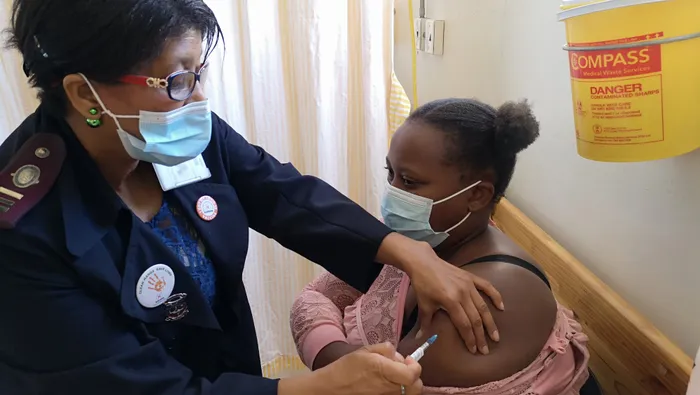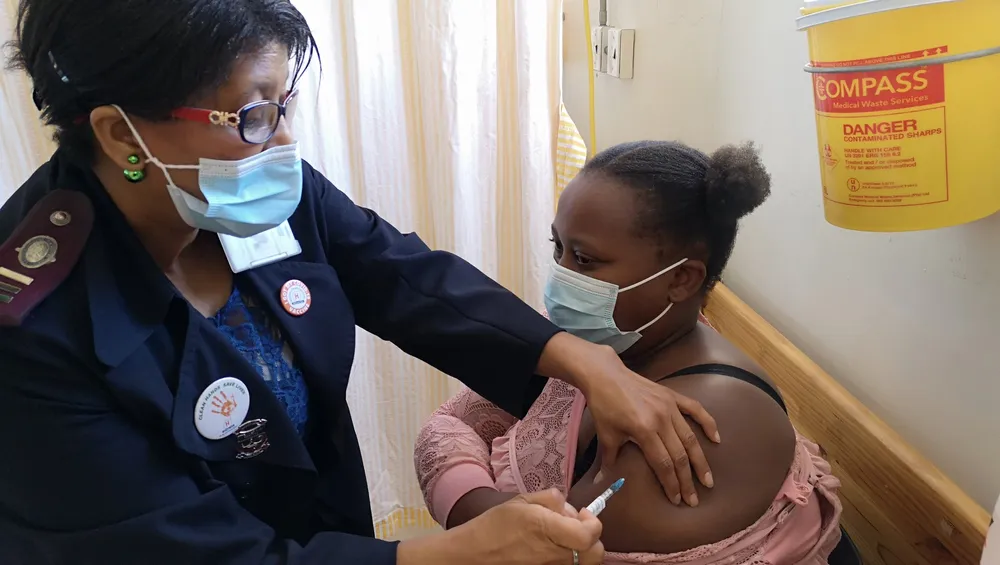The year that V was for vaccine and vote

Nurse Magdalena Swartbooi administers the Johnson & Johnson Covid-19 vaccine to her fellow nurse Nandipha Mneno.
The year started with the country on Alert Level 3 as the the national Covid-19 lockdown continued. This meant restrictions on many activities, and workplaces to address the high risk of transmission.

In January South Africa received 1 million doses of the Covid-19 vaccine and a further 500 000 doses of the Oxford University-AstraZeneca vaccine from the Serum Institute of India (SII), the following month.
As the vaccination programme rolled out across the city, more than 250 health care workers were vaccinated at Mitchell’s Plain District Hospital, as part of the phase 1 Johnson and Johnson Sisonke vaccination study (“Healthcare workers vaccinated”, Plainsman, March 24).
When government launched phase 2 of its vaccination plan, the focus was on those 60 years and older and the remaining health workers (“Phase 2 Pfizer vaccinations for over 60s”).
But mid-June, as temperatures dropped and winter settled in, the country shifted to Alert Level 4, having experienced a moderate to high increase in Covid-19 numbers.
In Mitchell’s Plain there has been a low vaccine uptake, with the area identified by local and provincial health authorities as one of the health sub-districts that require more intervention to ramp up the vaccination rate (“Vaccine hesitancy, fake news, access a problem”, Plainsman, August 25).
Soon after, the provincial opposition political party, the ANC, argued that the vaccine should be taken to people in their communities, at centres and schools (“Take vaccination to the people, says opposition”, Plainsman, September 8).
Ahead of the local government election, restrictions were relaxed to Alert Level 2 in time for voter registration in September and then dropped to Alert Level 1, a month before voting day.
This meant that normal activities were allowed to resume - but with precaution and protocols in place to prevent the spread of the virus.
As voters registered to be eligible to vote in the November local government election, the new ward demarcations caused confusion for many residents (“Ward confusion reigns”, Plainsman, September 22).
Changes in ward boundaries saw many residents being diverted from one registration station to another which prompted the Mitchell’s Plain United Residents’ Association (MURA) to call for more education on the changes ahead of the municipal elections.
Irrespective of the weather, voter turn out on November 1 did not change much from previous years as the Democratic Alliance (DA) won Mitchell’s Plain (“Blue voters”, Plainsman, November 3) , inclusive of nine wards, bordered by the R300, Swartklip Road, Baden Powell Drive and Strandfontein Road.

On Thursday November 18, as 19 Mitchell’s Plain councillors took their seats in the City of Cape Town, former Westridge ward councillor Eddie Andrews was named deputy mayor (“Mitchell’s Plain councillors officially take their seats”, Plainsman, November 24).
At about the same time a Tafelsig couple (“Tafelsig family offered their home as vaccination site”, Plainsman November 24). Explaining their decision, they said they were passionate about keeping their community safe and ensuring that vaccines were accessible to residents who could not afford to travel to their nearest vaccination site in Mitchell’s Plain.